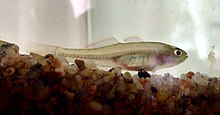
The Murray cod is a large Australian predatory freshwater fish of the genus Maccullochella in the family Percichthyidae. Although the species is called a cod in the vernacular, it is not related to the Northern Hemisphere marine cod (Gadus) species. The Murray cod is an important part of Australia's vertebrate wildlife—as an apex predator in the Murray-Darling River system—and also significant in Australia's human culture. The Murray cod is the largest exclusively freshwater fish in Australia, and one of the largest in the world. Other common names for Murray cod include cod, greenfish, goodoo, Mary River cod, Murray perch, ponde, pondi and Queensland freshwater cod.
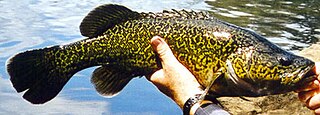
The eastern freshwater cod, also known as the eastern cod or Clarence River cod, is a large predatory freshwater fish of the genus Maccullochella and the family Percichthyidae, that occur in the coastal Clarence River system of north-eastern New South Wales. Eastern freshwater cod are closely related to the Murray cod of the Murray-Darling River system, and are considered an icon of the Clarence River system.
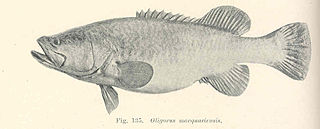
The trout cod or bluenose cod, is a large predatory freshwater fish of the genus Maccullochella and the family Percichthyidae, closely related to the Murray cod. It was originally widespread in the south-east corner of the Murray-Darling river system in Australia, but is now an endangered species.

The golden perch is a medium-sized, yellow or gold-coloured species of Australian freshwater fish found primarily in the Murray-Darling River system, though a subspecies is found in the Lake Eyre-Cooper Creek system, and another subspecies, suspected to be ancestral to all other populations, is found in the Fitzroy River system in Queensland. Other common names for golden perch are "goldens", “yellowbelly” and "callop", the last generally used only in South Australia.

The river blackfish is a freshwater fish endemic to the temperate waters of south-eastern Australia. It is found from southern Queensland through to central Victoria, including in the Murray-Darling river system. It is also found in some eastern and southern flowing coastal rivers. Found primarily in upland and "midland" habitats, though early records of fish fauna suggest it was originally far more extensively distributed and was found in some lowland habitats as well. Originally, river blackfish co-inhabited many of its lowland and "midland" habitats with species such as Murray cod and golden perch, and its upland habitats with species such as trout cod and Macquarie perch. It is a popular angling fish in some parts of its range.

Stream capture, river capture, river piracy or stream piracy is a geomorphological phenomenon occurring when a stream or river drainage system or watershed is diverted from its own bed, and flows down to the bed of a neighbouring stream. This can happen for several reasons, including:

Mogurnda clivicola, commonly known as the Flinders Ranges mogurnda, Flinders Ranges purple-spotted gudgeon, Barcoo, or Bulloo mogurnda, is a central Australian gudgeon of the family Eleotridae.

The Kessler's gudgeon is a European species of freshwater fish in the family Cyprinidae. It is found in the Danube and Vistula drainage basins, including parts of Poland, Austria, the Czech Republic, Ukraine, Bulgaria, Romania, Moldova, Hungary, Croatia, Bosnia and Herzegovina, Serbia, Montenegro, Slovakia, and Slovenia. It is a small fish of no economic or sporting importance. It was at one time classified as Gobio kessleri.

Agassiz's perchlet, also known as Agassiz's glass fish and the olive perchlet, is a species of ray-finned fish in the family Ambassidae. It is semi-transparent with dark scale edges forming a pattern over most of the body. It grows to a maximum of 7.5 cm. It is a macrophyte spawner with adhesive eggs. It is endemic to Australia. It was named for the zoologist Louis Agassiz.
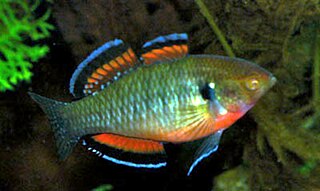
Hypseleotris is a genus of fishes in the family Eleotridae. Most are from fresh water in Australia and New Guinea, but species in fresh and brackish water are found around islands in the western Indian Ocean, southern and eastern Africa, southern and eastern Asia, and Pacific islands. The largest species reaches a length of 12 cm (4.7 in). They are sometimes seen in the aquarium trade; especially H. compressa. In Australia they are known as carp gudgeons.
The Prince Regent gudgeon is a species of fish in the family Eleotridae endemic to Australia, where it is only known to occur in clear, rocky pools in the Prince Regent Reserve in Western Australia. This species can reach a length of 5 cm (2.0 in).
The honey blue-eye is an endangered species of fish in the subfamily Pseudomugilinae. It is endemic to southeastern Queensland, Australia, where it is found in mildly acidic, often tannin-stained, ponds and streams in wallum habitat.
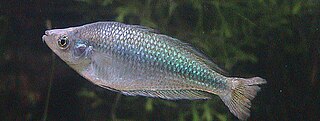
The Murray River rainbowfish, known less commonly as the Australian rainbowfish, is a species of freshwater fish endemic to southeastern Australia. The southernmost species of all rainbowfishes, these fish are very colourful, hence the name; and there is sexual dimorphism with the males being larger and more colourful than females. Murray River rainbowfish are schooling fish and will congregate near logs or riverbanks, and are a popular aquarium fish.

Stanulus talboti, Talbot's blenny, is a species of combtooth blenny found in coral reefs in the western Pacific Ocean. This species feeds primarily on plants, including benthic algae and weeds. This species can reach 4.8 cm (1.9 in) in TL. This fish is also found in the aquarium trade.

Carl Benjamin Klunzinger was a German physician and zoologist.

The ornate rainbowfish is a species of rainbowfish endemic to an area in eastern Australia, where it is native to coastal regions and sandy offshore islands in southern Queensland and northern New South Wales. It is the only known member of its genus. It is a popular aquarium fish.

Hypseleotris compressa, the empire gudgeon, is a species of Gobiiform fish in the family Eleotridae endemic to Australia and south-central New Guinea.

Craterocephalus eyresii, the Lake Eyre hardyhead, is a species of freshwater silverside from the family Atherinidae which is endemic to the Lake Eyre basin in Australia.
Oxyeleotris nullipora, the poreless gudgeon, is a gudgeon of the genus Oxyeleotris, a freshwater fish found in Australia and Papua New Guinea.

Aplodactylus westralis, the western sea carp or cockatoo morwong, is a species of marine ray finned fish, one of the marblefishes belonging to the family Aplodactylidae. It is found in the eastern Indian Ocean off the coast of Western Australia.
